Michigan hop scouting report – July 25, 2019
Hop downy mildew infections are widespread around Michigan and many growers are approaching a critical application window to protect cones from disease.

Despite a period of intensely hot weather, overall Michigan remains behind in degree day accumulation compared to the five-year average. The cool, wet spring greatly affected hop growth, weeds and pests. Symptoms of hop downy mildew are widespread and powdery mildew infections have been confirmed on a limited number of farms. Caterpillar pest populations seem higher this year than in the past and many growers have reported difficulty controlling potato leafhopper. The cool, wet spring delayed the development of mite populations, so many farms are just now seeing levels that warrant treatment. Rose chafer and Japanese beetle pressure is low in most locations.
Downy mildew
The cool, wet spring was conducive to hop downy mildew development. Downy mildew is caused by the fungal-like organism Pseudoperonospora humuli and is a significant disease of hop in Michigan, potentially causing substantial yield and quality losses. This disease affects cones, and foliage and can become systemic; in extreme cases, the crown may die. Disease severity is dependent on cultivar, environmental conditions and management programs. Focus on proactive management strategies, including sourcing clean planting stock, scouting regularly and utilizing a preventative fungicide program.
Scouting for downy mildew involves monitoring the crop for signs and symptoms of disease to evaluate the efficacy of the control program being utilized and gauge the level of disease pressure throughout the season.
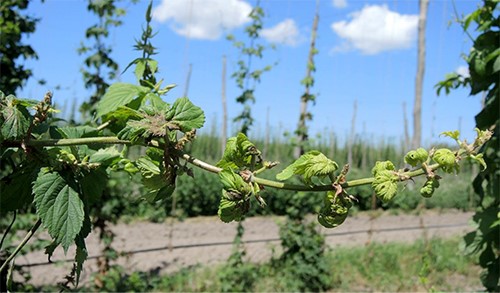
Unfortunately, even when best management practices are followed, downy mildew can gain a foothold in Michigan yards due to high disease pressure, challenges with fungicide application timing, suboptimal spray coverage, fungicide wash-off, cultivar susceptibility or a combination of these factors. In addition, fungicide resistance and infected nursery plants may play a role in some disease control failures. Recent research from Higgins et al., unpublished, indicates that fungicide resistance in hop downy mildew is not widespread in Michigan for popularly used fungicides with FRAC code 40. See the list of recommended fungicides below for more information on FRAC code 40 fungicides.
At this time in the season, growers should be applying fungicides for mildew management weekly. Continue applications all season long on a seven- to 10-day reapplication interval until harvest. The time between applications may stretch longer when the weather is dry and if hop yards don’t have active infections.

Several periods in the season are particularly critical for disease control: immediately before and after training; when lateral branches begin to develop; bloom; and cone development. Covering young, developing bracts before cones close is critical to protecting against downy mildew when conditions for disease are favorable. Getting adequate coverage on undersides of bracts where infection occurs becomes increasingly difficult as cones mature.
Ranman (cyazofamid, FRAC 21), Zampro (ametoctradin plus dimethomorph, FRAC 45 plus 40), Forum (dimethomorph, FRAC 40), Presidio (fluopicolid, FRAC 43, supplemental label) and Revus (mandipropamid, FRAC 40) make up the backbone of effective downy mildew management programs in Michigan. These products should be rotated and potentially (see labels) mixed with Curzate (cymoxanil, FRAC 27), Ridomil (metalaxyl, FRAC 4, drench) and phosphonate products such as Aliette (fosetyl-Al, FRAC 33) to help prevent resistance development. Copper-based fungicides may also be rotated in during periods of low disease pressure and as tank mix partners.
Note that Revus, Forum and Zampro contain active ingredients with the same mode of action and should not be tank-mixed or rotated, and Presidio is only available via a supplemental label that growers must have on hand for legal application.
Organic growers have fewer options and will need to focus on keeping tissue protected, selecting downy mildew tolerant varieties and following cultural practices to limit downy infection. Copper-based products are the mainstay of downy mildew management in organic hop yards and offer five to seven days of protection but no post-infection activity. Apply copper ahead of any wetting events as available. The preharvest intervals for copper formulations vary, so refer to the label. Actinovate, Eco-mate, Armicarb-O and Sonata are additional products that list downy mildew on the label and are approved for organic use in hop. The preharvest interval for these products are one day or less; at this time we have no data on the efficacy of these products.
For more information on hop downy mildew, refer to the Michigan State University Extension article, “Managing hop downy mildew in Michigan.”
Powdery mildew
Powdery mildew, caused by the fungus Podosphaera macularis, is an emerging disease in Michigan that has serious implications for growers. Powdery mildew has been confirmed in Michigan hopyards this season. Focus on proactive management strategies, including sourcing clean planting stock, scouting regularly and utilizing a preventative fungicide management program.
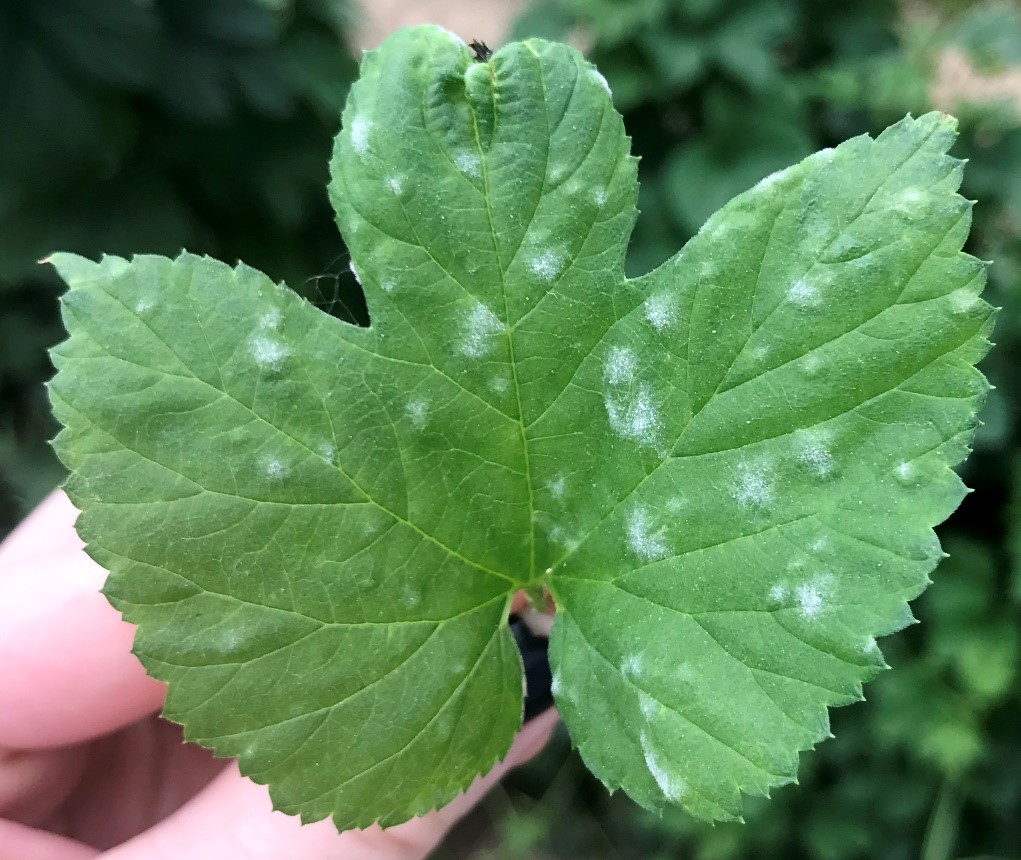
At this time of the year, growers should be scouting for leaf lesions. These secondary lesions become visible as leaf tissue expands and first appear as raised blisters, which quickly develop into white, round colonies. Infected burrs and cones can also support white fungal colonies or may exhibit a reddish discoloration if infected later in development.
Burrs and young cones are very susceptible to infection, which can lead to cone distortion, substantial yield reduction, diminished alpha-acids content, color defects, premature ripening, off-aromas and complete crop loss. Cones become somewhat less susceptible to powdery mildew with maturity, although they never become fully immune to the disease. Infection during the later stages of cone development can lead to browning and hastened maturity. Alpha-acids typically are not influenced greatly by late-season infections, but yield can be reduced by 20 percent or more due to shattering of overly dry cones during harvest resulting from accelerated maturity.
Late-season powdery mildew can be easily confused with other diseases such as Alternaria cone disorder, gray mold or spider mite damage. Several weak pathogens and secondary organisms can be found on cones infected by powdery mildew; limiting powdery mildew reduces these secondary organisms.
Conditions that favor powdery mildew are reported to include low light levels resulting from cloud cover, canopy density, excessive fertility and high soil moisture. Leaf wetness from dew or rain does not directly impact powdery mildew infection, but results from high humidity and cloud cover, which favors disease.
At this time of the season, regular fungicide applications are needed to prevent infection and are applied regardless of visible symptoms. Different fungicides are utilized for powdery mildew control during three distinct periods of the season: emergence to mid-June; mid-June to bloom; and bloom to preharvest. The Fungicide Resistance Action Committee (FRAC) mode of action classification codes are included to help growers make resistance management decisions.
Emergence to mid-June
Consider a combination of applications of sulfur (FRAC M2), oils, Flint (trifloxystrobin, FRAC 11), Rhyme (flutriafol, FRAC 3), Procure 480 SC (triflumizonle, FRAC 3) or Unicorn DF (tebuconazole plus sulfur, FRAC 3 plus M2). Under high pressure, tank-mix with oils and integrate copper (FARM m1) into your downy mildew programs when possible. Avoid tank mixes of copper and sulfur, as phytotoxicity may occur.
Mid-June to bloom
Consider Rhyme (flutriafol, FRAC 3), Procure 480 SC (triflumizole, FRAC 3), Luna Experience (fluopyram plus tebuconazole, FRAC 7 plus 3), Vivando (metrafenone, FRAC 50) and Torino (cyflufenamid, FRAC U6, download supplemental label). Under high pressure, tank-mix with oils and integrate copper into your downy mildew programs when possible.
Bloom to preharvest
Use a combination of Quintec (quinoxyfen, FRAC 13, 21-day preharvest interval), Pristine (pyraclostrobin plus boscalid, FRAC 11 plus 7, 14-day preharvest interval), Luna Sensation (fluopyram plus trifloxystrobin, FRAC 7 plus 11, 14-day preharvest interval), Vivando (metrafenone, FRAC 50, 14-day preharvest interval) and Torino (cyflufenamid, FRAC U6, six-day preharvest interval, download supplemental label).
Many fungicide programs can give adequate disease control on leaves when applied preventively under low disease pressure. On cones, however, differences among fungicides are substantial. Mid-July through early August is an essential disease management period. The fungicide Quintec (quinoxyfen), Luna Sensation (fluopyram plus trifloxystrobin), Vivando (metrafenone) and Torino (cyflufenamid) are especially effective during this time and should be utilized in regular rotation when burrs and cones are present.
Fungicide applications alone are not sufficient to manage the disease. Under high disease pressure, mid-season removal of diseased basal foliage delays disease development on leaves and cones by lowering inoculum and increasing airflow. Do not apply desiccant herbicides until bines have grown far enough up the string so that the growing tip will not be damaged and bark has developed. In trials in Washington, removing basal foliage three times with a desiccant herbicide (e.g., AIM) provided more control of powdery mildew than removing it once or twice. Established yards can tolerate some removal of basal foliage without reducing yield. This practice is not advisable in baby plantings (less than three years), and may need to be considered cautiously in some situations with sensitive varieties such as Willamette. The potential for quality defects and yield loss increases with later harvests when powdery mildew is present on cones.
Under the additional constraints imposed by organic production guidelines, particular attention must be paid to selection of disease-resistant varieties. Available fungicide options for organic production are minimal but would include products in FRAC code 44 (biopesticides), FRAC P5 and P7 (host plant induction) and various oil based products (e.g., Trilogy). These products are generally not effective under high disease pressure, making organic production very challenging.
Further, for these softer products to have any chance at controlling powdery mildew, prophylactic applications must be applied on less than seven-day intervals. Organic producers should consider sulfur or oil-based fungicides. Do not tank-mix sulfur and oil due to phytotoxicity issues. Although frequently cited in popular literature, optimal fertilization, soil health and water management alone are inadequate for disease control. Likewise, biorational compounds, manure teas and various botanicals and natural products have shown minimal to no efficacy against this pathogen under moderate to severe disease pressure.
For more information on powdery mildew, refer to the MSU Extension article, “Managing hop powdery mildew in Michigan.”
Potato leafhopper
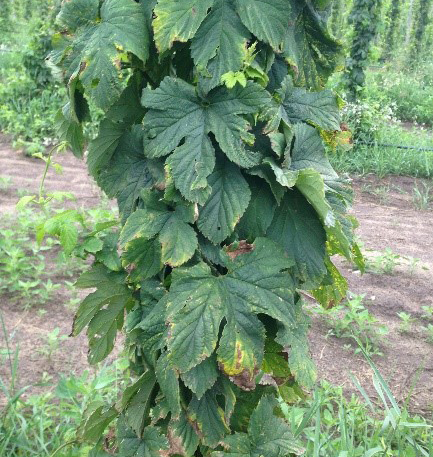
Potato leafhopper has been a real source of frustration for growers this year. Some growers who chemigated imidacloprid products this spring reported poor control; this might be due to high levels of rainfall and cool temperatures limiting plant uptake. Like many plants, hops are sensitive to the saliva of potato leafhopper, which is injected by the insect while feeding. Damage to leaf tissue can cause reduced photosynthesis, which can impact production, quality and cause death in baby plants.
To learn more about potato leafhopper, refer to the hop potato leafhopper fact sheet from MSU Extension.
Mites
Twospotted spider mite activity is visible. Twospotted spider mite is a significant pest of hop in Michigan and can cause complete economic crop loss when high numbers occur. Feeding decreases the photosynthetic ability of the leaves and causes direct mechanical damage to the hop cones. Leaves take on a bronzed and white appearance and can defoliate under high pressure. Intense infestations weaken plants, reducing yield and quality. Dry, hot weather provides ideal conditions for outbreaks.
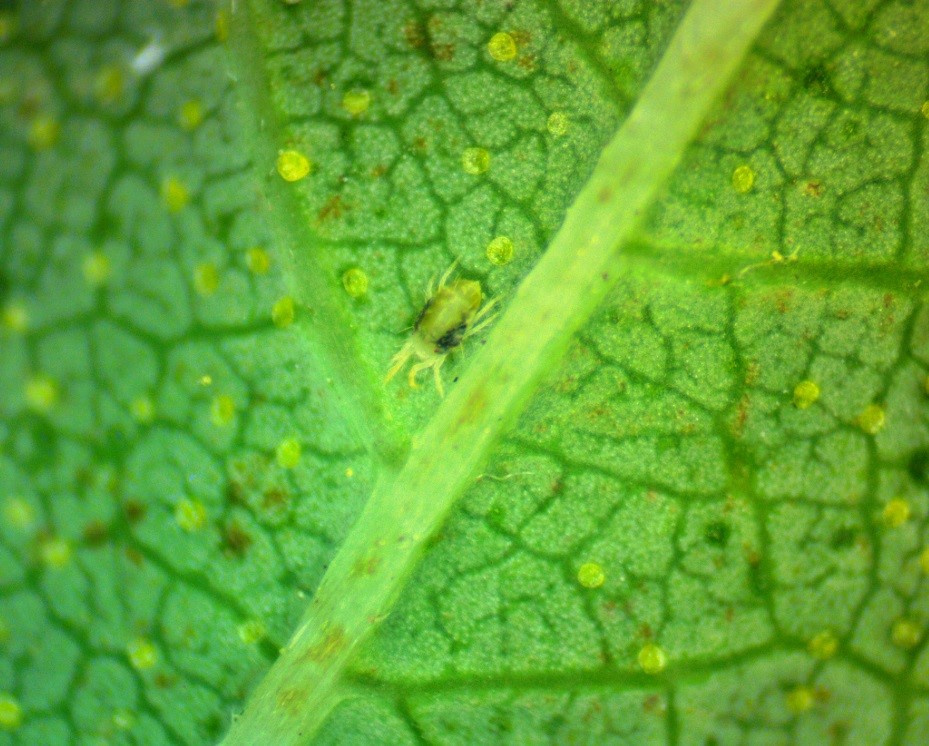
Mites are most effectively managed while still at low population levels. Scout carefully for mites season-long and treat while populations are at low levels. Refer to the twospotted spider mite fact sheet from MSU Extension for more information on identification and management.
Caterpillar pests have been more prevalent this year than in the past. Vigorous and healthy bines can take a substantial amount of feeding by caterpillars. Growers with baby plants will need to be more aggressive with management. Hop loopers, question mark larvae, tent caterpillars and a variety of other moth and butterfly larvae will all happily feed on hop. These caterpillars are relatively easy to control when needed through spot treatments. Labeled products containing the bio control Bacillus thuringiensis (Bt) are very effective at controlling small caterpillars.
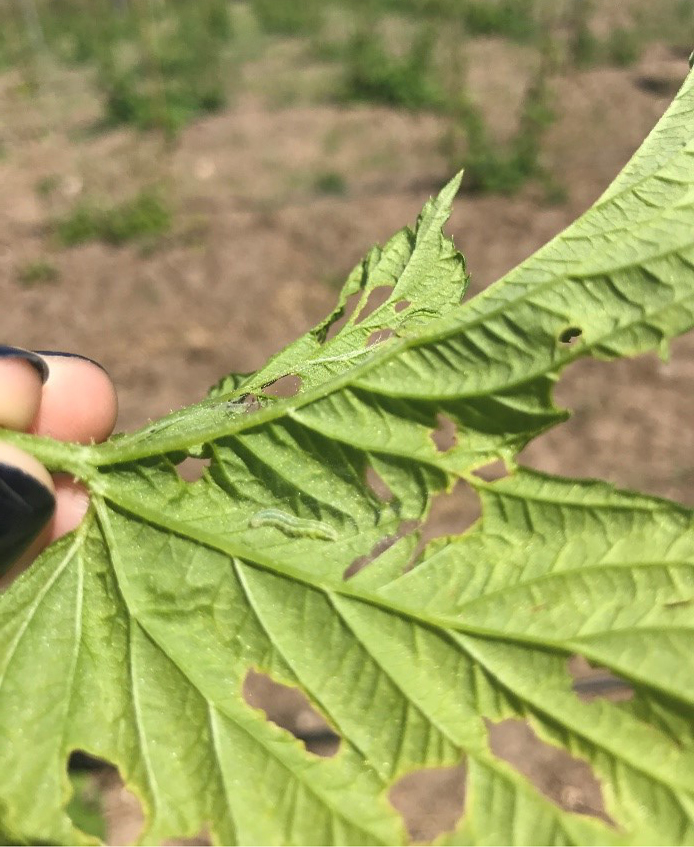
If you are unsure of what is causing symptoms in the field, you can submit a sample to MSU Plant & Pest Diagnostics. Visit the website for specific information about how to collect, package, ship and image plant samples for diagnosis. If you have any doubt about what or how to collect a good sample, please contact the lab at 517-432-0988 or pestid@msu.edu.
Stay in touch!
Want to receive more pest management information for hop this season? Sign up to receive the MSU Extension Fruit & Nuts Newsletter or follow us on Facebook. Also, join us this summer for monthly Bine and Dine webinars.
This material is based upon work supported by the USDA NIFA under Award No. 2017-700006-27175. Any opinions, findings, and conclusions or recommendations expressed in this publication are those of the author and do not necessarily reflect the view of the US Department of Agriculture.



 Print
Print Email
Email
